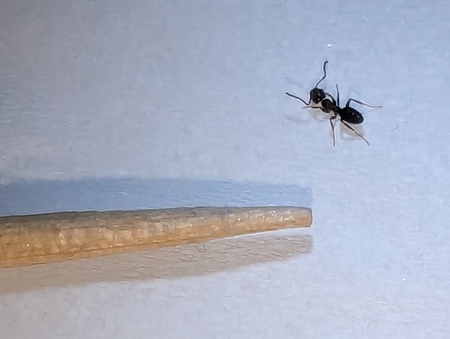
Good Natured: Odorous House Ant
Every year or so, right around this time, the dedicated staff at Good Natured World Headquarters starts compiling a list of the Signs of Spring.
In the past we've dutifully chronicled events like the male red-winged blackbirds' return and the pairing-off of Canada geese. But this year we considered going in a new, and potentially unpopular direction, documenting a teensy but regular occurrence we've witnessed every spring for the last decade. And since we is actually just I, the vote was unanimous.
We're going to talk about ants.
I noticed them the other day, marching one by one across the kitchen floor, from the trim next to the sliding glass door to the area where Kit, the senior furry roommate, takes her meals. The ants looked pretty much like they always have, except for one thing: Their numbers were considerably smaller.
Maybe it's Kit's Hoover-like suctioning of virtually every crumb of kibble, which keeps the dog bowl space nearly spotless; maybe it's because it's still early in the season. But whatever the reason, the few individuals I've spotted don't begin to compare to the quantity I've seen in years past.
You know what I have seen a lot of? Exterminator trucks, all over town. I'm guessing I'm not the only one experiencing an Ant Revival. But I'll betcha I'm the only one embracing it!
The ants in my kitchen are tiny creatures known scientifically as Tapinoma sessile, an eloquent name that my brain invariably twists into Tapioca—a carbohydrate these little house guests would relish, were it not securely stored in a sealed container.
If we look at the Greek root of the genus name (as opposed to the cassava root, from which tapioca is derived) we learn that the word means low or humble. As noted under the species page on BugGuide.net “The author may have referred to its general lowliness, to the physically depressed (slightly flattened) head and gaster (abdomen), or to its humble (brownish) coloration."
The specific name sessile is easier to interpret. Sessile means stalkless and refers to how this ant appears to lack a petiole—the slim section between an ant's thorax and abdomen. As the first part of the abdomen, the petiole gives ants their skinny “waist." Its appearance is an important feature in identifying ants and--for the record--T. sessile has one but it's hard to see.
You might have noticed, we haven't yet revealed the common name of this common ant—namely because it does the species no favors.
Some ants invite interest because of their cool-sounding names. The high noon ant, for example, evokes images of Gary Cooper in Western garb, waiting for that fateful noon train. And crazy ants make you think of, well, crazy aunts, either your own or others.
Meanwhile, the industrious creatures trying to eke out a living by my back door are known as odorous house ants. The name stems from the scent they emit when crushed, which reportedly smells like rotten coconuts.
True Story: The other day, in the interest of science, I picked one up. I couldn't justify killing it but hoped my imposing presence would be enough to scare out some odor. As the ant scrambled across my fingers I gave a sniff, but all I could smell was the garlic powder from the snack mix I'd been munching. Even after a very scientific handwashing and the capture of another specimen…nada.
Perhaps that defensive chemical is of more use to OHAs outside, where they also live, albeit in smaller numbers. There they recycle the nutrients in dead insects as well as other animals, “farm" aphids for honeydew, and serve as food for several species of birds. Yet we rarely pay attention to these activities, as a) the outdoors is home to so many other types of ants; b) OHAs live in the soil, under bark and other hidden spaces; and b) OHAs are teeny weeny, measuring just 3mm, which is not quite 1/8 in.
True Story No. 2: Hoping to photograph this species, I put one in a jar and placed it in the freezer for a few minutes. When I took it out, the tiny ant was motionless, and quickly adhered to the condensation that formed on the glass. I felt bad, but consoled myself with the thought of possibly squishing and sniffing the decedent. Within about 5 minutes though, I kid you not, the small creature reanimated, first wiggling its little legs, then cleaning its antennae, then scrambling away to rejoin its kin.
In reading species accounts of T. sessile, it seems this fortitude is one of its most notable attributes. As mymecologist Marion R. Smith noted in his 1928 account, The Biology of Tapinoma sessile (Say), an Important House-infesting Ant, “The hardiness of the ants is most remarkable. On a number of occasions the writer has accidentally broken off appendages, or even crushed the bodies of the female and workers, yet these specimens lived and appeared to be little affected by the injuries."
Petite, resilient and stinky are only a small sampling of the odorous house ant's many fascinating traits. Next week we'll delve deeper, introducing another ant scientist and suggesting some ideas for natural control of this species that is at once relevant, vibrant, brilliant and, yes, abundant.
Pam Otto is the outreach ambassador for the St. Charles Park District. She can be reached at potto@stcparks.org.

